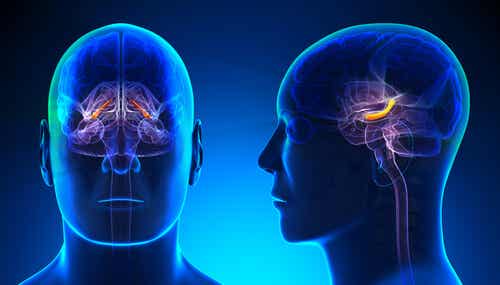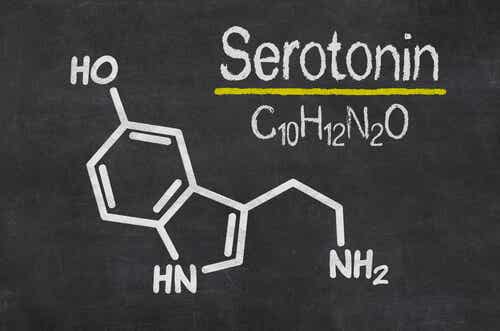The Neurobiology of Anxiety

As you most likely know, anxiety is one of the most common disorders affecting people today. In addition, since the start of the global coronavirus pandemic, the use of anti-anxiety drugs has spiked sharply in the US. However, what exactly is the neurobiology of anxiety? Let’s take a look at how it’s produced in the body.
Anxiety is related to the anticipation of future, indefinite, and unforeseeable dangers. One of its main traits is that it’s anticipatory. In other words, it has the ability to foresee or point out danger or a threat to the person. Therefore, anxiety has an important functional role.
Studies in animals, mainly in rodents, have identified specific areas of the brain that are associated with anxiety. It appears that the amygdala, prefrontal cortex, thalamus, and hippocampus play an integral role in our pathological and adaptive fear responses.
There are also neuroimaging and pharmacological studies that indicate how to understand the neurobiology of anxiety. Let’s take a closer look at some different areas of the brain that have an impact on anxiety.

The neurobiology of anxiety: areas of the brain
Amygdala: responses to fear
The area of the brain responsible for acquiring and expressing fear is the amygdala. This is located within the medial temporal lobe and is made up of about 13 nuclei. Three of these are involved in fear response (anxiety) pathways. These are:
- The basal nuclei.
- The lateral nuclei.
- The central nuclei.
Projections from the amygdala target neural, autonomic, and musculoskeletal systems associated with anxiety and fear-response mechanisms.
In addition, the amygdala functions as a regulatory center. In fact, it evaluates internal and external information and determines whether a fight or flight response is appropriate.
Locus coeruleus (LC)
This tiny blue spot is a nucleus located deep in the brainstem. It’s the brain’s main source of noradrenaline. The following regulate it:
- GABA benzodiazepine and serotonergic receptors with inhibitory effects.
- The vasoactive intestinal peptide (VIP).
- Corticotropin-releasing factor (CRF).
- Substance P.
- Acetylcholine, with activating effects.
The LC is like an alert center in the brain. Thus, it begins to activate when the brain detects a threat.
Thalamus
The thalamus is close to the center of the brain. When the brain senses a dangerous situation, the thalamus relays sensory signals to the amygdala. In fact, when this structure gets damaged, the brain doesn’t produce a fear reaction to acoustic stimuli.
The neurobiology of anxiety: Hypothalamus
The hypothalamus contains several small nuclei. It plays an important role in many processes, including activation and releasing of some stress-related substances.
Periaqueductal gray (PAG)
This gray matter influences your response to fear. For example, if you’re facing an imminent danger such as an animal attack, the PAG will define what defensive behavior you’ll carry out. Alternatively, when it decides you’re in a less dangerous situation, it may dictate immobility
Hippocampus and anxiety
The hippocampal system has connections with both limbic structures and cortical sensory areas. It has a high density of 5-HT1A receptors. As a result, it plays an important role in anxiety.

Orbitofrontal cortex and emotional responses
This structure has an important role in interpreting emotionally meaningful events. In fact, it selects and plans the response to a threat. It also monitors how effective those responses are.
Neurotransmitters involved in the neurobiology of anxiety
Noradrenaline (NA)
Noradrenaline (NA) is a substance that functions as a neurotransmitter. NA also stimulates a part of the nervous system called the sympathetic nervous system. It affects anxiety via NA and adrenaline signal b-adrenergic receptors. These provoke some anxiety symptoms, such as sweating, flushing, and trembling.
Serotonin and anxiety
Although the role of serotonin in anxiety isn’t completely clear yet, it may influence the following:
- Panic disorder.
- Obsessive-compulsive disorder.
- The effectiveness of SSRIs.

GABA and the neurobiology of anxiety
GABA plays an extremely important role in the function of the central nervous system. Furthermore, benzodiazepines used for the treatment of anxiety can enhance the activity of GABA.
As you can see, many different parts of the brain are involved in anxiety disorders. In fact, getting to know how they work together will help you better understand how the brain functions, and how different treatment options work.
As you most likely know, anxiety is one of the most common disorders affecting people today. In addition, since the start of the global coronavirus pandemic, the use of anti-anxiety drugs has spiked sharply in the US. However, what exactly is the neurobiology of anxiety? Let’s take a look at how it’s produced in the body.
Anxiety is related to the anticipation of future, indefinite, and unforeseeable dangers. One of its main traits is that it’s anticipatory. In other words, it has the ability to foresee or point out danger or a threat to the person. Therefore, anxiety has an important functional role.
Studies in animals, mainly in rodents, have identified specific areas of the brain that are associated with anxiety. It appears that the amygdala, prefrontal cortex, thalamus, and hippocampus play an integral role in our pathological and adaptive fear responses.
There are also neuroimaging and pharmacological studies that indicate how to understand the neurobiology of anxiety. Let’s take a closer look at some different areas of the brain that have an impact on anxiety.

The neurobiology of anxiety: areas of the brain
Amygdala: responses to fear
The area of the brain responsible for acquiring and expressing fear is the amygdala. This is located within the medial temporal lobe and is made up of about 13 nuclei. Three of these are involved in fear response (anxiety) pathways. These are:
- The basal nuclei.
- The lateral nuclei.
- The central nuclei.
Projections from the amygdala target neural, autonomic, and musculoskeletal systems associated with anxiety and fear-response mechanisms.
In addition, the amygdala functions as a regulatory center. In fact, it evaluates internal and external information and determines whether a fight or flight response is appropriate.
Locus coeruleus (LC)
This tiny blue spot is a nucleus located deep in the brainstem. It’s the brain’s main source of noradrenaline. The following regulate it:
- GABA benzodiazepine and serotonergic receptors with inhibitory effects.
- The vasoactive intestinal peptide (VIP).
- Corticotropin-releasing factor (CRF).
- Substance P.
- Acetylcholine, with activating effects.
The LC is like an alert center in the brain. Thus, it begins to activate when the brain detects a threat.
Thalamus
The thalamus is close to the center of the brain. When the brain senses a dangerous situation, the thalamus relays sensory signals to the amygdala. In fact, when this structure gets damaged, the brain doesn’t produce a fear reaction to acoustic stimuli.
The neurobiology of anxiety: Hypothalamus
The hypothalamus contains several small nuclei. It plays an important role in many processes, including activation and releasing of some stress-related substances.
Periaqueductal gray (PAG)
This gray matter influences your response to fear. For example, if you’re facing an imminent danger such as an animal attack, the PAG will define what defensive behavior you’ll carry out. Alternatively, when it decides you’re in a less dangerous situation, it may dictate immobility
Hippocampus and anxiety
The hippocampal system has connections with both limbic structures and cortical sensory areas. It has a high density of 5-HT1A receptors. As a result, it plays an important role in anxiety.

Orbitofrontal cortex and emotional responses
This structure has an important role in interpreting emotionally meaningful events. In fact, it selects and plans the response to a threat. It also monitors how effective those responses are.
Neurotransmitters involved in the neurobiology of anxiety
Noradrenaline (NA)
Noradrenaline (NA) is a substance that functions as a neurotransmitter. NA also stimulates a part of the nervous system called the sympathetic nervous system. It affects anxiety via NA and adrenaline signal b-adrenergic receptors. These provoke some anxiety symptoms, such as sweating, flushing, and trembling.
Serotonin and anxiety
Although the role of serotonin in anxiety isn’t completely clear yet, it may influence the following:
- Panic disorder.
- Obsessive-compulsive disorder.
- The effectiveness of SSRIs.

GABA and the neurobiology of anxiety
GABA plays an extremely important role in the function of the central nervous system. Furthermore, benzodiazepines used for the treatment of anxiety can enhance the activity of GABA.
As you can see, many different parts of the brain are involved in anxiety disorders. In fact, getting to know how they work together will help you better understand how the brain functions, and how different treatment options work.
All cited sources were thoroughly reviewed by our team to ensure their quality, reliability, currency, and validity. The bibliography of this article was considered reliable and of academic or scientific accuracy.
- Marks, I. (1986). Tratamiento de neurosis. Barcelona:
- Martínez Roca.Phelps, E. A., & LeDoux, J. E. (2005). Contributions of the amygdala to emotion processing: from animal models to human behavior. Neuron, 48(2), 175-187.
- Paré, D., Quirk, G. J., & Ledoux, J. E. (2004). New vistas on amygdala networks in conditioned fear. Journal of neurophysiology, 92(1), 1-9.
- Rosen, J. B. (2004). The neurobiology of conditioned and unconditioned fear: a neurobehavioral system analysis of the amygdala. Behavioral and cognitive neuroscience reviews, 3(1), 23-41.
- Cedillo Ildefonso, B. (2017). Generalidades de la neurobiología de la ansiedad. Revista Electrónica de Psicología Iztacala, 20(1), 239-251.
- Goddard, A. W., & Charney, D. S. (1997). Toward an integrated neurobiology of panic disorder. The Journal of clinical psychiatry.
This text is provided for informational purposes only and does not replace consultation with a professional. If in doubt, consult your specialist.







